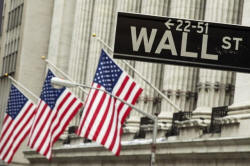|
Bond-trading bump shows
Wall Street banks doing more with less
 Send a link to a friend
Send a link to a friend
 [January 19, 2017]
By Olivia Oran [January 19, 2017]
By Olivia Oran
(Reuters) -
Wall
Street banks once earned huge profits by encouraging bond traders to
swing for the fences, but their fourth-quarter results show how
dramatically that model has changed.
Bond trading was the star of the show as finance chiefs and chief
executive officers reviewed sharp gains in fourth-quarter profits over
the past week. Revenue from the business contributed $11.7 billion to
the collective top line of Wall Street's five biggest banks, up 46
percent from the year-ago period.
Bank executives uniformly attributed the gains to more clients doing
more trading. And each of the five banks reported lower metrics for
"value at risk," a metric that tries to gauge how much money an
institution might lose in trading on a given day.
The smallest of the bunch, Morgan Stanley <MS.N>, said bond revenue more
than doubled, even after it cut staff by 25 percent and shrunk
risk-weighted assets in the business by $41 billion.
It was a markedly different description than the bond-market boom times
of a decade ago, when Morgan Stanley's then-CEO described how the bank
was fishing for "attractive opportunities" to produce record results. At
the time, its trading value-at-risk was more than double the current
level.
“There has been a rebuff of the risk-taking culture at banks since the
crisis," said Francesco D'Acunto, an assistant professor of finance at
the University of Maryland who has published research on bank culture.

The fourth-quarter results may provide some support for what bank
executives have been saying for years: that bond trading was in a
temporary funk, and would recover once clients started trading more.
Those assertions came in response to questions about whether the
business was permanently crippled by regulations imposed after the 2008
financial crisis, ratcheting up capital requirements and putting
restrictions on banks' ability to place big bets with their own capital.
But the fourth quarter brought a surge in trading volumes across
commodities, interest rate products and foreign exchange as investors
reworked their portfolios in response to Donald Trump's surprise victory
in the U.S. presidential election and the Federal Reserve's interest
rate hike.
Banks benefited by simply acting as intermediaries for buyers and
sellers.
"Everyone said that banks wouldn't make money after the crisis, but
that's clearly not true," said Dave Ellison, a portfolio manager at
Hennessy Funds, which holds Morgan Stanley shares. "They're now adapting
to a new environment and learning they don't need to take on the type of
risk they did in the past."
[to top of second column] |

A sign hangs in front of U.S. flags outside of the New York Stock
Exchange in New York September 1, 2015. REUTERS/Lucas Jackson

Looking ahead, bank executives struck an optimistic tone. Citigroup Inc's <C.N>
finance chief, John Gerspach, said the positive trends have continued into 2017,
while his counterpart at Goldman Sachs Group Inc, Harvey Schwartz, predicted
"meaningful upside" for the bond-trading business.
Bond trading at Citi rose 36 percent during the quarter, while Goldman saw a
gain of 78 percent. The mood on big banks' trading floors is a bit more somber.
Even with the recent uptick, bond trading profits are about half what they were
at their peak, JPMorgan Chase & Co CEO Jamie Dimon said last month.
Fixed income trading at JPMorgan rose 31 percent in the fourth quarter. It
increased 20 percent at Bank of America Corp <BAC.N>, as CEO Brian Moynihan said
the trading outlook for the first quarter was strong just several weeks into
2017.
In response, management teams have cut thousands of traders in recent years, and
those who remain are being paid less with more strings attached.
Traders are now scrutinized more than ever throughout their banks, not just by
their managers.
In 2016, Morgan Stanley began asking risk and compliance officers to evaluate
so-called "material risk takers" such as bankers and traders. This feedback now
plays a factor in promotion and compensation decisions.
D'Acunto, of the University of Maryland, said banks have tried to break away
from the testosterone-fueled culture that once thrived, in part by promoting
more diversity on trading floors. They have also tried to implement a more
team-like atmosphere, rather than encouraging competition between traders on the
same desk.
"It's all about changing dynamics on the trading floor," he said. "Institutions
can no longer act like 'The Wolf of Wall Street.'"
(Reporting by Olivia Oran in New York; Editing by Lauren Tara LaCapra and Lisa
Shumaker)
[© 2017 Thomson Reuters. All rights
reserved.] Copyright 2017 Reuters. All rights reserved. This material may not be published,
broadcast, rewritten or redistributed.
 |